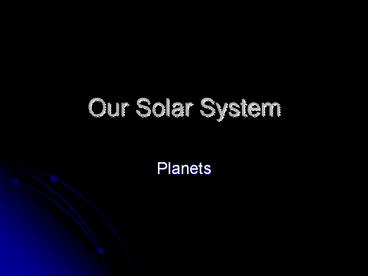Our Solar System - PowerPoint PPT Presentation
1 / 14
Title:
Our Solar System
Description:
Landform Drainage - Geology For Kids - By KidsGeo.com. Earth made up of air, ... Galileo Galilee discovered 4 ... Galileo Galilee. One of greatest ... – PowerPoint PPT presentation
Number of Views:73
Avg rating:3.0/5.0
Title: Our Solar System
1
Our Solar System
- Planets
2
Our Planet- Earth
- Third Planet from the Sun
- Biggest of all planets
- Landform Drainage - Geology For Kids - By
KidsGeo.com - Earth made up of air, water, land and life.
- Air is synonym for atmosphere
- Atmosphere made up of variety of gases
- Earth has layers
- Rocky planet (terrestrial)
- Only planet with life on it (as of now)
3
Earth cont- Ozone Layer
- Ozone layer- layer in atmosphere contains high
concentration of ozone (O3) - 97-99 of the sun's high frequency, ultraviolet
light, which is potentially damaging to life on
Earth.
4
Earths Moon
- Natural satellite
- Covered with craters
- No atmosphere causing space rocks to smash it.
- No air and weak gravity
- When sun shines, moon gets very hot, and when sun
doesnt shine, moon gets very cold!
5
Mercury
- Small and rocky
- Closest to the sun
- Completes the trip around the sun every 88 days.
- Length of one Mercury day is about 59 days on
Earth - Has no moons
- Named after ancient Roman god of trade and profit
- No water
6
Venus
- 2nd Planet from our sun
- Very similar to Earth, although doesnt have an
ocean - Covered with clouds that trap heat and reflects
sunlight, which is why usually it is the
brightest planet in the sky. (Hottest Planet) - 2nd Brightest object in the sky, the first is the
moon - Has no Moons
- Named after Roman goddess of love and beauty
- Spins backwards
7
Mars
- Red Planet because of its red soil
- Small rocky body and similar to Earth, but dusty
and dry and much smaller than Earth. - 4th planet from the sun
- Named after Roman god of war
- Has 2 moons Phobos (fear) and Deimos (panic)
- Thin air- mostly carbon dioxide and very harmful
to humans
8
Jupiter
- Huge Planet, Biggest in our solar system, with 49
moons! - 5th planet from the sun
- Named for the King of ancient Roman gods
- Giant ball of gas, no place to land!
- Galileo Galilee discovered 4 of the biggest
moons. - Jupiters stripes are cold, windy clouds of
ammonia and water - The giant red spot is a storm that has lasted for
over hundreds of years. - Dangerous atmosphere, containing of hydrogen and
helium.
9
Saturn
- 6th planet from the Sun
- Jewel of the system because of its rings
- 2nd largest planet
- Named for ancient Roman god of agriculture.
- Made up of mostly gas.. doesnt have a solid
surface. Clouds on planet are mostly yellow and
white - Rings made up of billions of chunks of ice and
rock - Has at least 49 moons
10
Uranius
- 7th planet from the sun
- 3rd largest planet in the solar system
- Named for Roman god who was the father of the
Titans. - Very cold and windy and like most other planets
very poisonous to humans. - It is a gas planet like Neptune, Jupiter and
Saturn - The atmosphere gets thicker and thicker until it
is squished into liquid.
11
Neptune
- 8th Planet from the sun
- 4th largest planet in the solar system
- Named for the Roman god of the sea
- Windiest planet in the solar system
- 6 rings and 13 known moons
- Gets blue color from a layer of methane gas above
the clouds.
12
Pluto
- Smallest, coldest, and most distant planet from
the sun. - New dwarf planet
- Named for Roman god of the Underworld
- May be the largest of the group of icy objects
just beyond Neptune called the Kuiper Belt. The
Kuiper Belt is made up of millions of icy and
rocky objects. - Has 3 moons
- Very cold and no air
13
Math Wonders!
- The average distance from the Earth to the Sun is
93,000,000 miles or 149 million kilometers or
what scientists call Astronomical Units or A.U. - It would take 142 days to get to the moon going
70 mph.
- Multiply your Earth weight by Your "new" weight
- Mercury 0.4 Venus 0.9 Earth 1 Moon 0.17 Mars
0.4 Jupiter 2.5 Saturn 1.1 Uranus 0.8 Neptune
1.2 Pluto 0.01 Sun 28
14
Galileo Galilee
- One of greatest astronomers of all the world.
- 1st person to use a telescope to look at the
universe. - He studied the sun, planets and the moon.
- Noticed four stars around Jupiter, which turned
out to be moons. - This proved the moon can revolve around the
earth, while the earth revolves around the sun.































